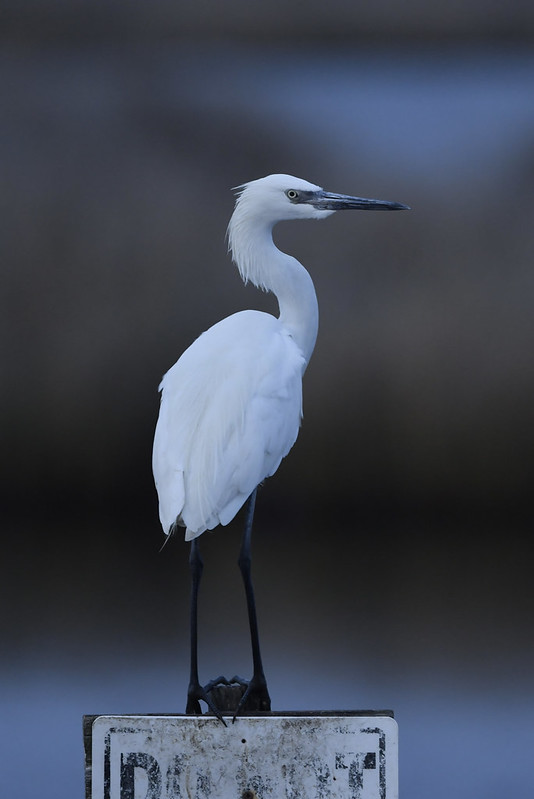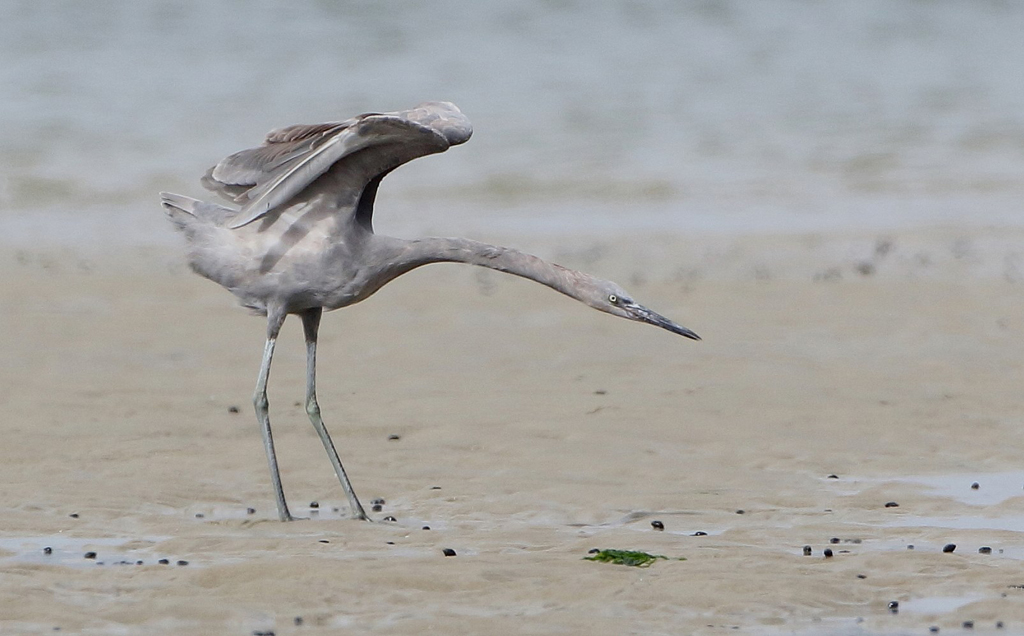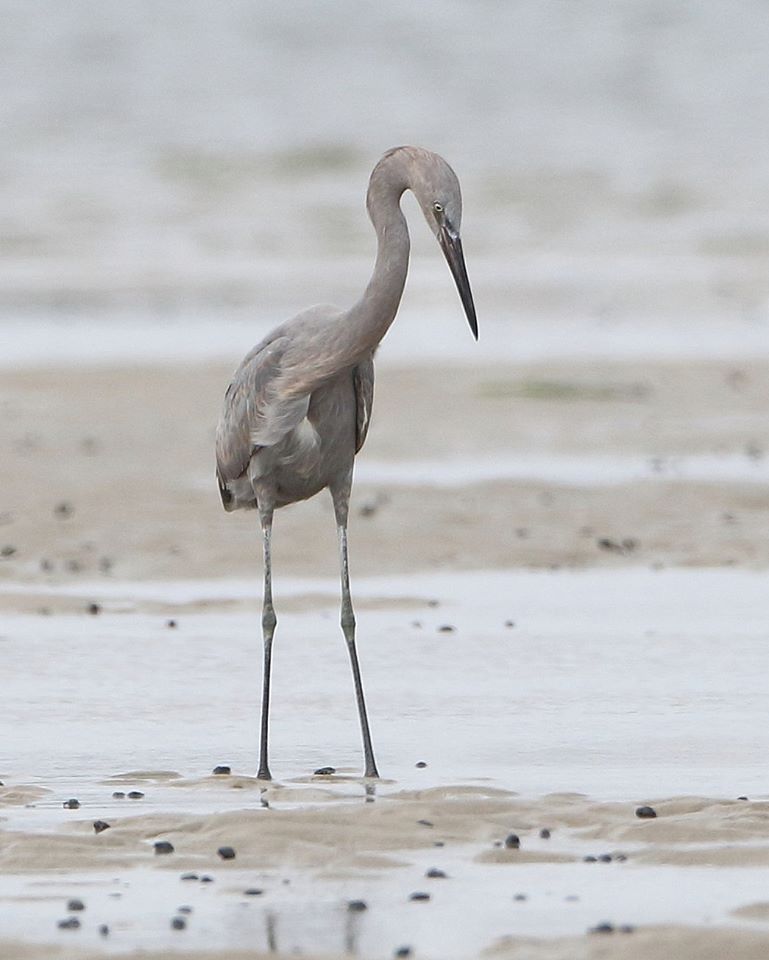Map Snapshot



6 Records
Status
Maryland's first accepted record was an immature bird found on Skimmer Island, Worcester Co., Maryland (6/23/2003) (John Hubbell, #2003-106). Dan Small found the state's second record at Skimmer Island on 9/28/2015.
Where To Find
Our two records are from Skimmer Island. Similar habitats on the coast also have potential in post-breeding dispersal season.
Seasonality Snapshot
Source: Wikipedia
| Reddish egret | |
|---|---|

| |
| Reddish egret in breeding plumage at Fort Desoto, Florida, US | |
| Scientific classification | |
| Domain: | Eukaryota |
| Kingdom: | Animalia |
| Phylum: | Chordata |
| Class: | Aves |
| Order: | Pelecaniformes |
| Family: | Ardeidae |
| Genus: | Egretta |
| Species: | E. rufescens
|
| Binomial name | |
| Egretta rufescens (Gmelin, 1789)
| |

| |
Breeding Year-round Nonbreeding
| |
| Synonyms[2] | |
| |
The reddish egret (Egretta rufescens) is a medium-sized heron that is a resident breeder in Central America, the Bahamas, the Caribbean, the Gulf Coast of the United States (primarily Texas), and Mexico. The egret is known for its unusual foraging behavior compared to other herons as well as its association with mud flats, its habitat of choice.
In the past, this bird was a victim of the plume trade and is North America’s "rarest and least studied ardeid."[3]
Taxonomy
[edit]The reddish egret was formally described in 1789 by the German naturalist Johann Friedrich Gmelin in his revised and expanded edition of Carl Linnaeus's Systema Naturae. He placed it with the herons, cranes and egrets in the genus Ardea and coined the binomial name Ardea rufescens.[4] Gmelin based his description on that of the English ornithologist John Latham who in 1785 had included the species in his multi-volume A General Synopsis of Birds.[5] Latham had in turn based his own description on the "L'Aigrette rousse, de la Louisiane" that the French polymath Comte de Buffon had described and illustrated in his Histoire Naturelle des Oiseaux.[6][7] The reddish egret is now placed with 12 other species in the genus Egretta that was introduced in 1817 by the German naturalist Johann Reinhold Forster.[8][9] The genus name comes from the Provençal French word for the little egret, aigrette, a diminutive of aigron, "heron". The specific epithet rufescens is Latin meaning "reddish".[10]
Two subspecies are recognised:[9]
- E. r. rufescens (Gmelin 1789) – south USA, West Indies and Mexico
- E. r. dickeyi (Van Rossem, 1926) – Baja California (Mexico)
Description
[edit]
This species reaches 68–82 cm (27–32 in) in length, with a 116–125 cm (46–49 in) wingspan.[11][12] Body mass in this species can range from 364–870 g (0.802–1.918 lb).[13] Among standard linear measurements, the wing chord is 29–34.3 cm (11.4–13.5 in), the tail is 8.8–13 cm (3.5–5.1 in), the bill is 7.3–9.2 cm (2.9–3.6 in) and the tarsus is 11.7–14.7 cm (4.6–5.8 in).[14] It is a medium-sized, long-legged, long-necked heron with a long pointed pinkish bill with a black tip. It is distinctly larger than other co-existing members of the genus Egretta, but smaller than the great blue heron and great egret. The legs and feet are bluish-black. While the sexes are similar, there are two distinct color morphs. The adult dark morph has a slate blue body and reddish head and neck with shaggy plumes. The adult white morph has entirely white body plumage. Young birds have a brown body, head, and neck. During mating, the male's plumage stands out in a ruff on its head, neck and back. The bird's usual cry is a low, guttural croak.
Behavior
[edit]The reddish egret is considered one of the most active herons, and is often seen on the move.[3] It stalks its prey (fish, frogs, crustaceans, and insects) in shallow water, typically near mud flats, while frequently running energetically and using the shadow of its wings to reduce glare on the water once it is in position to spear its prey.[3] Due to its bold, rapacious yet graceful feeding behavior and its typical proximity to mud flats, author Pete Dunne nicknamed the reddish egret "the Tyrannosaurus rex of the Flats".[15]: 135
Breeding
[edit]The reddish egret is a resident breeder in Central America, The Bahamas, the Caribbean, the Gulf Coast of the United States, and Mexico.[16] Its breeding habitat is tropical swamps. It nests in colonies, often with other herons, usually on platforms of sticks in trees or shrubs.[13] These colonies are usually located on coastal islands.[citation needed] In Texas, however, these nests are often built on the ground, sometimes on oyster shell beaches.[11] These birds have raucous courtship displays. They generally involve shaking of the head during the greeting ceremony, followed by chases and circle flights. They also involve raising of the neck, back and crest feathers, accompanied by bill clacking,[13] similar to the tricolored heron (Egretta tricolor).[17]
According to the Texas Parks and Wildlife Department, there are only 1,500 to 2,000 nesting pairs of reddish egrets in the United States — and most of these are in Texas.[11] They are classified as "threatened" in Texas and receive special protection.[11]
Gallery
[edit]-
Canopy hunting
-
With great egret at Long Key State Park
-
Intermediate morph in Jacksonville, Florida
-
Fishing the mangroves, Lac Cai, Bonaire
-
Canopy fishing, Lac Cai, Bonaire
-
Reddish Egret (Bolsa Chica Wetlands - Huntington Beach, CA)
References
[edit]- ^ BirdLife International (2020). "Egretta rufescens". IUCN Red List of Threatened Species. 2020: e.T22696916A154076472. doi:10.2305/IUCN.UK.2020-3.RLTS.T22696916A154076472.en. Retrieved 12 November 2021.
- ^ "Egretta rufescens (Gmelin, 1789)". Global Biodiversity Information Facility. Retrieved 25 March 2023.
- ^ a b c Koczur, Lianne M.; Green, M. Clay; Ballard, Bart M.; Lowther, Peter E.; Paul, Richard T. (2020). Rodewald, P.G. (ed.). "Reddish Egret (Egretta rufescens), version 1.0". Birds of the World. Ithaca, New York: Cornell Lab of Ornithology. doi:10.2173/bow.redegr.01.
- ^ Gmelin, Johann Friedrich (1789). Systema naturae per regna tria naturae : secundum classes, ordines, genera, species, cum characteribus, differentiis, synonymis, locis (in Latin). Vol. 1, Part 1 (13th ed.). Lipsiae [Leipzig]: Georg. Emanuel. Beer. p. 628.
- ^ Latham, John (1785). A General Synopsis of Birds. Vol. 3, Part 1. London: Printed for Leigh and Sotheby. p. 88, No. 56.
- ^ Buffon, Georges-Louis Leclerc de (1780). "L'Aigrette rousse". Histoire Naturelle des Oiseaux (in French). Vol. 7. Paris: De l'Imprimerie Royale. p. 378.
- ^ Buffon, Georges-Louis Leclerc de; Martinet, François-Nicolas; Daubenton, Edme-Louis; Daubenton, Louis-Jean-Marie (1765–1783). "L'Aigrette rousse, de la Louisiane". Planches Enluminées D'Histoire Naturelle. Vol. 10. Paris: De L'Imprimerie Royale. Plate 902.
- ^ Forster, T. (1817). A Synoptical Catalogue of British Birds; intended to identify the species mentioned by different names in several catalogues already extant. Forming a book of reference to Observations on British ornithology. London: Nichols, son, and Bentley. p. 59.
- ^ a b Gill, Frank; Donsker, David; Rasmussen, Pamela, eds. (August 2022). "Ibis, spoonbills, herons, Hamerkop, Shoebill, pelicans". IOC World Bird List Version 12.2. International Ornithologists' Union. Retrieved 28 November 2022.
- ^ Jobling, James A. (2010). The Helm Dictionary of Scientific Bird Names. London: Christopher Helm. pp. 143, 341. ISBN 978-1-4081-2501-4.
- ^ a b c d "Reddish Egret (Egretta rufescens)". Texas Parks and Wildlife Department. Retrieved 25 March 2023.
- ^ "Reddish Egret". World Association of Zoos and Aquariums. Archived from the original on 2018-05-08. Retrieved 2012-03-29.
- ^ a b c "Reddish Egret". All About Birds. Cornell Lab of Ornithology.
- ^ Lowther, Peter E.; Paul, Richard T. (2002). Poole, A. (ed.). "Reddish Egret (Egretta rufescens)". The Birds of North America Online. Ithaca, New York: Cornell Lab of Ornithology. doi:10.2173/bna.633.
- ^ Dunne, Pete (2006). Pete Dunne's Essential Field Guide Companion: A Comprehensive Resource for Identifying North American Birds. Houghton Mifflin Harcourt. ISBN 0-618-23648-1. Retrieved 25 March 2023 – via Internet Archive.
- ^ BirdLife International (2023). "Species factsheet: Egretta rufescens". BirdLife Species Factsheets. BirdLife International. Retrieved 25 March 2023.
- ^ "Tricolored Heron". HeronConservation. Key Biscayne, Florida. 2023. Retrieved 25 March 2023.











